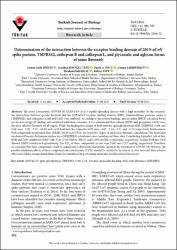| dc.contributor.author | İstifli, Erman Salih | |
| dc.contributor.author | Şıhoğlu Tepe, Arzuhan | |
| dc.contributor.author | Netz, Paulo A. | |
| dc.contributor.author | Sarıkürkçü, Cengiz | |
| dc.contributor.author | Kılıç, İbrahim Halil | |
| dc.contributor.author | Tepe, Bektaş | |
| dc.date.accessioned | 2022-05-10T10:45:49Z | |
| dc.date.available | 2022-05-10T10:45:49Z | |
| dc.date.issued | 30.08.2021 | en_US |
| dc.identifier.citation | Istifli, E. S., Tepe, A. Ş., Netz, P. A., Sarikürkcü, C., Kilic, I. H., & Tepe, B. (2021). Determination of the interaction between the receptor binding domain of 2019-nCoV spike protein, TMPRSS2, cathepsin B and cathepsin L, and glycosidic and aglycon forms of some flavonols. Turkish Journal of Biology, 45(4), 484-502. | en_US |
| dc.identifier.issn | 1300-0152 | |
| dc.identifier.issn | 1303-6092 | |
| dc.identifier.uri | https://doi.org/10.3906/biy-2104-51 | |
| dc.identifier.uri | https://hdl.handle.net/20.500.12933/965 | |
| dc.description.abstract | The novel coronavirus (COVID-19, SARS-CoV-2) is a rapidly spreading disease with a high mortality. In this research, the interactions between specific flavonols and the 2019-nCoV receptor binding domain (RBD), transmembrane protease, serine 2 (TMPRSS2), and cathepsins (CatB and CatL) were analyzed. According to the relative binding capacity index (RBCI) calculated based on the free energy of binding and calculated inhibition constants, it was determined that robinin (ROB) and gossypetin (GOS) were the most effective flavonols on all targets. While the binding free energy of ROB with the spike glycoprotein RBD, TMPRSS2, CatB, and CatL were –5.02, –7.57, –10.10, and –6.11 kcal/mol, the values for GOS were –4.67, –5.24, –8.31, and –6.76, respectively. Furthermore, both compounds maintained their stability for at least 170 ns on respective targets in molecular dynamics simulations. The molecular mechanics Poisson–Boltzmann surface area (MM/PBSA) calculations also corroborated these data. Considering Lipinski’s rule of five, ROB and GOS exhibited 3 (MW>500, N or O>10, NH or OH>5), and 1 (NH or OH>5) violations, respectively. Neither ROB nor GOS showed AMES toxicity or hepatotoxicity. The LD50 of these compounds in rats were 2.482 and 2.527 mol/kg, respectively. Therefore, we conclude that these compounds could be considered as alternative therapeutic agents in the treatment of COVID-19. However, the possible inhibitory effects of these compounds on cytochromes (CYPs) should be verified by in vitro or in vivo tests and their adverse effects on cellular energy metabolism should be minimized by performing molecular modifications if necessary. | en_US |
| dc.language.iso | eng | en_US |
| dc.publisher | Scientific and Technical Research Council of Turkey | en_US |
| dc.relation.isversionof | 10.3906/biy-2104-51 | en_US |
| dc.rights | info:eu-repo/semantics/openAccess | en_US |
| dc.subject | 2019-nCoV | en_US |
| dc.subject | Spike glycoprotein | en_US |
| dc.subject | TMPRSS2 | en_US |
| dc.subject | CatB | en_US |
| dc.subject | CatL | en_US |
| dc.subject | Flavonol | en_US |
| dc.subject | Molecular docking | en_US |
| dc.subject | Molecular dynamics | en_US |
| dc.subject | MM/PBSA | en_US |
| dc.title | Determination of the interaction between the receptor binding domain of 2019-nCoV spike protein, TMPRSS2, cathepsin B and cathepsin L, and glycosidic and aglycon forms of some flavonols | en_US |
| dc.type | article | en_US |
| dc.authorid | 0000-0001-5094-2520 | en_US |
| dc.department | AFSÜ, Eczacılık Fakültesi, Temel Eczacılık Bilimleri Bölümü | en_US |
| dc.contributor.institutionauthor | Sarıkürkçü, Cengiz | |
| dc.identifier.volume | 45 | en_US |
| dc.identifier.issue | 4 | en_US |
| dc.identifier.startpage | 484 | en_US |
| dc.identifier.endpage | 502 | en_US |
| dc.relation.journal | Turkish Journal of Biology | en_US |
| dc.relation.publicationcategory | Makale - Ulusal Hakemli Dergi - Kurum Öğretim Elemanı | en_US |
















